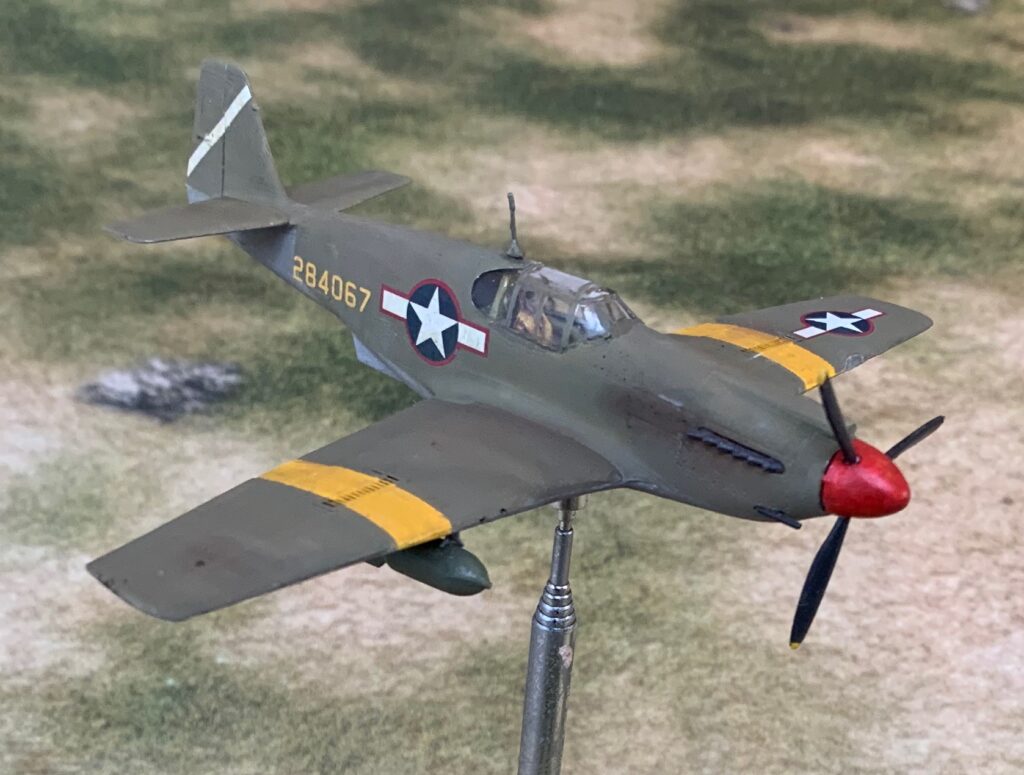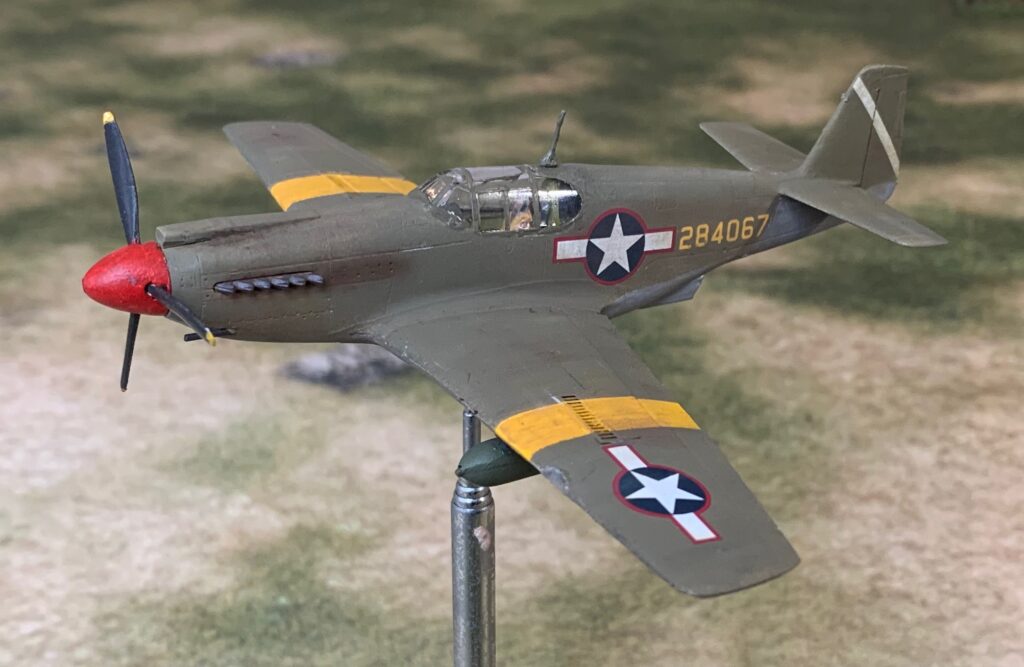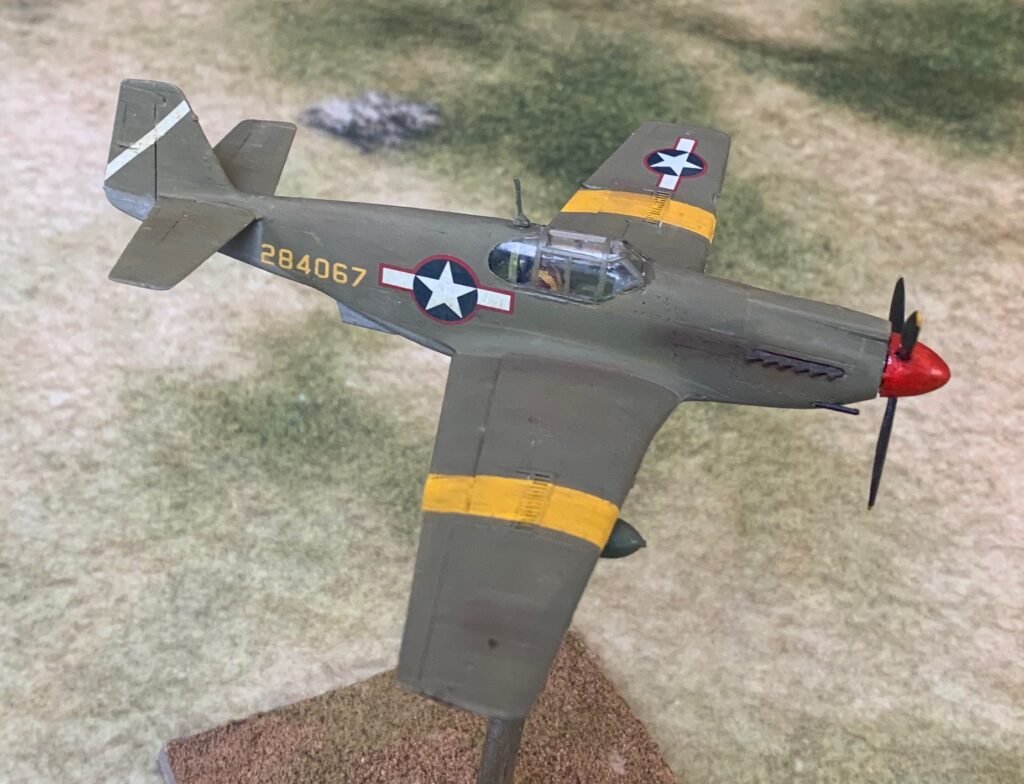
And now to the last of my recent batch of US aircraft: the A-36 Apache. Unlike the other two aircraft, which were more or less ubiquitous to the US war effort, this one had limited use. But t it was one of the most important aircraft types in US use in 1943 in the Mediterranean theatre, especially in the ground attack role – so bang in scope for my project. There were very limited options for modelling it though – with the Brengun kit being the most obvious. It wasn’t a great kit, but much easier than the RZ P-38.

The A-36 is, of course, an early version of the North American Mustang, which in its P-51 incarnation became one of the most important aircraft types in the war. It was named “Apache” by the makers, but this never caught on. In theatre there was a move to call it “Invader”, but eventually the name of its fighter cousin was the one generally in use. It was powered by an Allison engine, as were the first P-51s. This rendered disappointing performance at higher altitudes, and it wasn’t until it was powered by the Merlin engine that the type really came into its own. Doubtless this led to the development of the ground attack version, where it would operate primarily at lower altitudes. This included the fitting of dive brakes, which allowed it to do near-vertical, Stuka-like, dive-bombing attacks. I’m not sure how often it used this capability, which required experienced pilots, and I think it more typically used shallower dives (like the RAF used for the P-40 Kittyhawk, its equivalent aircraft). Its successor, the P-47, did not have this capability. Some were armed with four 20mm cannon – but this option was not available in the Brengun kit, where the plane has six 0.5in machine-guns, including two in the nose. The aircraft could look after itself if it met fighter opposition, and, apparently, 86 kills were claimed in combat, with one ace. It was used as an escort fighter on occasion, but wasn’t so popular with bomber crews, as it was easy to mistake its profile for the Bf-109 or Fw-109 – as well its lack of performance at higher altitudes. A-36 was highly effective in its fighter-bomber role, apparently, but suffered from high casualty rates. That partly went with the job of tackling well-defended targets at low altitudes – but there were structural vulnerabilities, especially compared to the P-40 and P-47. They were in use until well into 1944, though.

The kit was OK-ish. There was the usual lack of lugs and recesses to hold parts in place, and no undercarriage up option. But the undercarriage doors weren’t too hard to fit. Some parts didn’t fit properly, especially on the underside. That included the air intake, and the vent behind it, which left an ugly gap. The air brakes for the underwing didn’t fit either (thought the ones on the top of the wing were OK). I ended up by bodging the intake a bit, but this is invisible from most angles. The rear cockpit was a bit awkward, as the overhanging bit of the fuselage above of the rear side windows was moulded into the canopy part. This mean it had to be seamlessly integrated into the fuselage, and then painted (which is trickier on acetate). There was no question of adding the canopy after the paint job, as I did with the P-38. But I now understand that this is usually better anyway. Filler helps integrate it with the fuselage. I didn’t do an especially nice job with the aerial, but this was tricky, as it required a hole to be drilled – not easy on acetate.

I decided to model plane 42-84067, which was included in the decal pack, and on the box art. But the decals were for 1944, when it had completed lots of missions. I wanted it as it might have looked in Sicily or Salerno. That meant the only decals from the box I used were the number and the ID stripe on the tail (which probably dated from this time). The over painted battle ID letter “A” was almost certainly later. The national insignia needed the red outline, so I used my trusty sheet from eBay. It has the yellow ID stripes on the wing, which seem to be standard on US single-engined aircraft in the Med. These stripes were painted first and then masked – as overpainting pale colours onto Olive Drab is hard work. Nevertheless the yellow paint was didn’t go on very nicely, and it looks a bit rough. As with the P-38 the red spinner is a bit bright in hindsight.

And that’s it – an interesting aircraft to support my tabletop forces, which ended up looking pretty good.